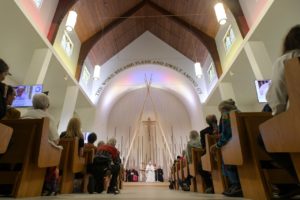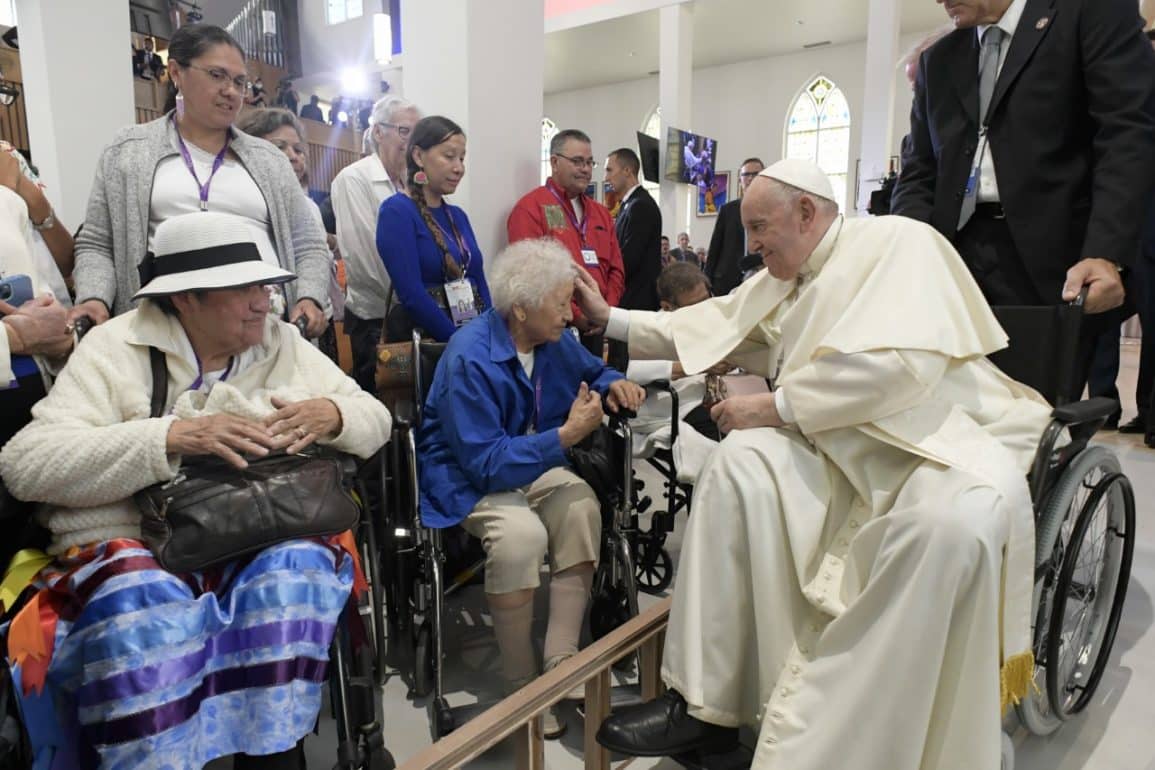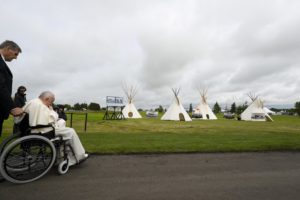In the afternoon, leaving St. Joseph Seminary, the Holy Father Francis moved by car to the Church of the Sacred Heart, where – at 4.45 pm (00.45 am Rome time) – he met the Indigenous Peoples and the Members of the Parish Community.
Upon his arrival he is welcomed at the entrance of the church by the parish priest, Father Susai Jesu, O.M.I., and enters accompanied by the sound of drums.
After the words of welcome of the parish priest and the testimony of two parishioners members of the Council and the execution of an indigenous song, the Pope delivers his speech.
Then, after the recitation of the Our Father and the final Blessing, Pope Francis greets some of the faithful and, on leaving, blesses the statue of St. Kateri Tekakwitha, the first indigenous to North America to have been proclaimed a saint by the Catholic Church.
At the end of the meeting, the Holy Father returns by car to St. Joseph Seminary where he has dinner in private.
The following is the address that the Holy Father addressed to those present during the meeting:
Speech of the Holy Father
Dear brothers and sisters, good evening!
I am happy to be here among you and to see once again the faces of the various indigenous representatives who came to visit me in Rome several months ago. That visit meant a lot to me, and now I have come to visit your home, as a friend and pilgrim in your land, in this church where you gather to praise God as brothers and sisters. In Rome, after I listened to your stories, I stated that “any truly effective process of healing requires concrete actions” (Address to Representatives Indigenous Peoples in Canada, 1 April 2022). So I am pleased to see that in this parish, where people of different communities of the First Nations, the Métis and the Inuit come together with nonindigenous people from the local area and many of our immigrant brothers and sisters, this effort has already begun. This place is a house for all, open and inclusive, just as the Church should be, for it is the family of the children of God, where hospitality and welcome, typical values of the indigenous culture, are essential. A home where everyone should feel welcome, regardless of past experiences and personal life stories. I also want to thank you for the concrete closeness you show to many poor people – for they are numerous, even in this rich country – through your works of charity. That is what Jesus asks of us, for as he tells us over and over in the Gospel: “Just as you did it to one of the least of these who are members of my family, you did it to me” (Mt 25:40).
Yet we must not forget that in the Church too, the wheat is mixed with tares. And precisely because of those tares, I wanted to make this penitential pilgrimage, which I began this morning by recalling the wrong done to the indigenous peoples by many Christians and by asking with sorrow for forgiveness. It pains me to think that Catholics contributed to policies of assimilation and enfranchisement that inculcated a sense of inferiority, robbing communities and individuals of their cultural and spiritual identity, severing their roots and fostering prejudicial and discriminatory attitudes; and that this was also done in the name of an educational system that was supposedly Christian. Education must always start from respect and the promotion of talents already present in individuals. It is not, nor can it ever be, something pre-packaged and imposed. For education is an adventure, in which we explore and discover together the mystery of life. Thanks be to God, for in
parishes like this, day by day, through encounter, foundations are being laid for healing and reconciliation.

You, my dear indigenous brothers and sisters, have much to teach us about the symbolism and vital meaning of the tree. Joined to the earth by its roots, a tree gives oxygen through its leaves and nourishes us by its fruit. It is impressive to see how the symbolism of the tree is reflected in the architecture of this church, where a tree trunk symbolically unites the earth below and the altar on which Jesus reconciles us in the Eucharist in “an act of cosmic love” that “joins heaven and earth, embracing and penetrating all creation” (Laudato Si’, 236). This liturgical symbolism reminds me of the magnificent words spoken by Saint John Paul II in this country: “Christ animates the very centre of all culture. Thus, not only is Christianity relevant to the Indian people, but Christ, in the members of his Body, is himself Indian” (Liturgy of the Word with the Native Peoples of Canada, 15 September 1984). On the cross, Christ reconciles and brings back together everything that seemed unthinkable and unforgivable; he embraces everyone and everything. Everyone and everything! The indigenous peoples attribute a powerful cosmic significance to the cardinal points, seen not only as geographical reference points but also as dimensions that embrace all reality and indicate the way to heal it, as embodied by the so-called “medicine wheel”. This church appropriates that symbolism of the cardinal points and gives it a Christological meaning. Jesus, through the four extremities of his cross, has embraced the four cardinal points and has brought together the most distant peoples; he has brought healing and peace to all things (cf. Eph 2:14). On the cross, he accomplished God’s plan: “to reconcile all things” (cf. Col 1:20).
Dear brothers and sisters, what meaning does this have for people who bear within their hearts such painful wounds? I can only imagine the effort it must take, for those who have suffered so greatly because of men and women who should have set an example of Christian living, even to think about reconciliation. Nothing can ever take away the violation of dignity, the experience of evil, the betrayal of trust. Or take away our own shame, as believers. Yet we need to set out anew, and Jesus does not offer us nice words and good intentions, but the cross: the scandalous love that allows his hands and feet to be pierced by nails, and his head to be crowned with thorns. This is the way forward: to look together to Christ, to love betrayed and crucified for our sake; to look to Christ, crucified in the many students of the residential schools. If we want to be reconciled with one another and with ourselves, to be reconciled with the past, with wrongs endured and memories wounded, with traumatic experiences that no human consolation can ever heal, our eyes must be lifted to the crucified Jesus; peace must be attained at the altar of his cross. For it is precisely on the tree of the cross that sorrow is transformed into love, death into life, disappointment into hope, abandonment into fellowship, distance into unity. Reconciliation is not merely the result of our own efforts; it is a gift that flows from the crucified Lord, a peace that radiates from the heart of Jesus, a grace that must be sought.
There is another aspect of reconciliation that I would like to mention. The Apostle Paul explains that Jesus, by means of the cross, has reconciled us in one body (cf. Eph 2:14). What body is he talking about? It is the body of the Church. The Church is this living body of reconciliation. If we think of the lasting pain experienced in these places by so many people within ecclesial institutions, we feel nothing but anger and shame. That happened because believers became worldly, and rather than fostering reconciliation, they imposed their own cultural models. This attitude dies hard, also from the religious standpoint. Indeed, it may seem easier to force God on people, rather than letting them draw near to God. Yet this never works, because that is not how the Lord operates. He does not force us, he does not suppress or overwhelm; instead, he loves, he liberates, he leaves us free. He does not sustain with his Spirit those who dominate others, who confuse the Gospel of our reconciliation with proselytism. One cannot proclaim God in a way contrary to God himself. And yet, how many times has this happened in history! While God presents himself simply and quietly, we always have the temptation to impose him, and to impose ourselves in his name. It is the worldly temptation to make him come down from the cross and show himself with power. Yet Jesus reconciles us on the cross, not by coming down from the cross. At the foot of the cross, were those who thought only of themselves and kept tempting Christ, telling him to save himself (cf. Lk 23:35.36) and not think of others. In the name of Jesus, may this never happen again in the Church. May Jesus be preached as he desires, in freedom and charity. In every crucified person whom we meet, may we see not a problem to be solved, but a brother or sister to be loved, the flesh of Christ to be loved. May the Church, the Body of Christ, be a living body of reconciliation!
The word “reconciliation” is in fact practically synonymous with the word “Church”. It comes from the word “council”, and it means “meet again in council”. The Church is the house where we “conciliate” anew, where we meet to start over and to grow together. It is the place where we stop thinking as individuals and acknowledge that we are brothers and sisters of one another. Where we look one another in the eye, accept the other’s history and culture, and allow the mystique of togetherness, so pleasing to the Holy Spirit, to foster the healing of wounded memories. This is the way: not to decide for others, not to pigeonhole everyone within our preconceived categories, but to place ourselves before the crucified Lord and before our brothers and sisters, in order to learn how to walk together. That is what the Church is, and should always be – the place where reality is always superior to ideas. That is what the Church is, and always should be – not a set of ideas and precepts to drill into people, but a welcoming home for everyone! That is what the Church is, and always should be: a building with doors always open, where all of us, as living temples of the Spirit, encounter one another, serve one another and are reconciled with one another. Dear friends: gestures and visits can be important, but most words and deeds of reconciliation take place at the local level, in communities like this, where individuals and families travel side-by-side, day by day. To pray together, to help one another, to share life stories, common joys and common struggles: this is what opens the door to the reconciling work of God.
One final image can help us in this. Here, in this church, above the altar and tabernacle, we see the four poles of a typical indigenous tent, a teepee. This teepee has deep biblical symbolism. When Israel journeyed in the desert, God dwelt in a tent that was set up every time that the people stopped and camped: it was the Tent of Meeting. The teepee reminds us that God accompanies us on our journey and loves to meet us together, in assembly, in council. And when he became man, the Gospel tells us, he literally “pitched his tent among us” (cf. Jn 1:14). God is a God of closeness, and in Jesus he teaches us the language of compassion and tender love. That is what we should call to mind every time that we enter a church, where Jesus is present in the tabernacle, a word that itself originally meant “tent”. Therefore, God has placed his tent in our midst; he accompanies us through our deserts. He does not dwell in heavenly mansions, but in our Church, which he wants to be a house of reconciliation.
Lord Jesus, crucified and risen, you dwell here, in the midst of your people, and you want your glory to shine forth through our communities and in our cultures. Take us by the hand, and even through the deserts of history, continue to guide our steps on the way of reconciliation. Amen.











